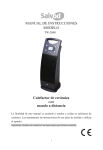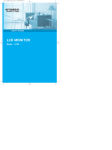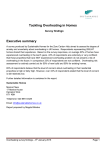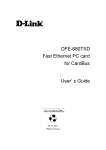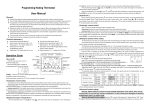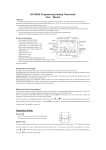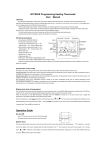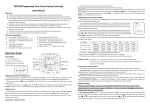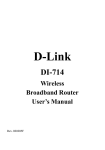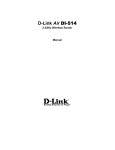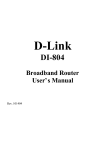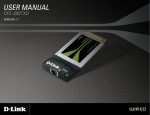Download D-Link DHN 1000 (DHN
Transcript
DHN-1000 HomeLink PhoneLine to Ethernet Bridge User's Manual Table of Contents for the DHN-1000 HomeLink Phoneline to Ethernet Bridge Introduction i Contents of Package ii Ethernet Technology 1 Networking with DHN-1000 2 Getting to Know your DHN-1000 3 Installation 4 Troubleshooting 10 Networking Basics 13 Technical Support 40 Specifications 41 Warranty 47 Registration 50 INTRODUCTION Thank you for purchasing D-Link's DHN-1000 HomeLink Phoneline to Ethernet Bridge. The DHN-1000 simplifies Ethernet to Home phone line networking. Being compatible with HPNA 2.0, Internet sharing has never been easier through your Broadband Cable/xDSL modems. A stand-alone device, the DHN-1000 is completely independent of any Operating system. The DHN-1000 has one RJ-45 10/100 NWay, and one RJ-11 HPNA 2.0 connection. You simply connect both ends, and you're in business! There is no software to configure. The DHN-1000 is targeted for the home or small office. i CONTENTS OF PACKAGE C D A B DHN-1000 HomeLink PhoneLine to Ethernet Bridge A Power Supply B Cables: RJ-45; RJ-11 C User’s Manual D Quick Install Guide ii ETHERNET TECHNOLOGY Networking today has opened a whole new world in data communications. Networking is simply connecting individual computers in a way so that they can share resources such as files, applications, and peripherals connected to the Local Area network (LAN). The most popular and cost efficent type of network is an “Ethernet” network, which has created a large abundance of Ethernet products on the market today. A Local Area Network is the most convenient way to share information and resources. A LAN is a network that covers a “local” area, like a floor or building. It let’s you easily transfer files between PCs, share printers, and share a Cable or DSL modem among several users. The basic components of a network are: PC’s, Cables, Network Interface Cards (NICs), Hubs or Switches, and Network Operating Systems (NOS). Functions and Features: One RJ-45 NWAY Auto sensing Ethernet port One RJ-11 HomePNA port Power Adapter 1 Networking with DHN-1000 Cat5 10/100 Ethernet Cable DI-704 Residential Gateway Cable or DSL Modem Cat5 Cable DFE-680TX PCMCIA Adapter DHN-1000 (HPNA to Ethernet Bridge) 10Mb HPNA 2.0 Phoneline LAN DFE-530TX+ PCI 10/100 Adapter DHN-120 (USB HPNA Adapter) Phone jack Cat5 Cable Printer DHN-520 (HPNA PCI Adapter) 2 GETTING TO KNOW YOUR DHN-1000 HPNA 10 Mb BRIDGE Power Supply Port RJ-45 Port 10/100 Mb Ethernet Switch RJ-11 Port (HPNA) HPNA 2.0 HPNA 2.0 RJ-11 port. Connect to your RJ-11 tele phone line outlet. LAN Connect to an Ethernet PC or Residential Gateway 10/100Mb RJ-45 port. Power Connect your power suply to your DHN-1000 Bridge 3 INSTALLATION RJ-45 Cable RJ-11 Cable (Ethernet) (telephone) Step 1: Figure 1 - Gently insert the RJ-45 Cat5 cable into DHN-1000 4 INSTALLATION continued Step 2: Figure 2 - Insert RJ-11 into HomePNA Port 5 INSTALLATION continued Step 3: Figure 3 - Install DHN-520 HomePNA adapter into the PC and connect RJ-11 6 INSTALLATION continued Step 4: Figure 4 - Connect the RJ-11 phone line from your DHN-1000 to your existing phone line outlet. 7 INSTALLATION continued Step 5: Residential Gateway RJ-45 cable DHN 1000 Figure 5- Connect the DHN-1000 Ethernet port to a DI-704 Residential Gateway. 8 INSTALLATION continued Figure 6 - DHN-1000 Indicator lights DHN-1000 HomePNA Ethernet Bridge l l l l Power indicator Ethernet port indicator HPNA HomePNA port Activity indicator, (when blinking it shows network activity) 9 TROUBLESHOOTING Computer Networking can be easy to install and maintain, giving the user the ability to share and transfer files. Occasionally, network problems arise and the user is faced with having to troubleshoot the network problem. Taking the best approach to trouble shooting a network problem is to start at the very simplest level and work your way up. On the following pages we have covered common troubleshooting situations. Please read the following section. (Please see the disclaimer on page 43). UNDERSTANDING INDICATORS DHN-1000 HomePNA Ethernet Bridge Power Ethernet HPNA Activity Indicator Lights: Power The power LED will light up when DHN-1000 is powered up. Ethernet Will light up when corresponding port is sending data over the network. HPNA Will light when HPNA to Ethernet is being bridged. Activity Will light up when there is network activity. 10 TROUBLESHOOTING Problem 1: The LEDs on my DHN-1000 are not lighting up. Solutions · l Make sure the DHN-1000 bridge is plugged into · l · l a power strip. Make sure that your HPNA network does not exceed 1,000 feet. If your HPNA PC's are more than 1,000 feet apart, your network performance may be diminished, which may result in data loss. Make sure that your RJ-45 cable is properly inserted into the DHN-1000's Ethernet port as well as your Gateway or Switch. Problem 2: My DHN-1000 is not working. Solutions · l · l Make sure the Cat5 cable from the Gateway to the DHN-1000 is in good condition. When connecting the bridge to your PC, Switch or Gateway, make sure all your network devices are powered down. Connect all cables to your devices, then power on. Problem 3: Cannot get connected to the LAN network using only a 10/100Mb Ethernet NIC card and HPNA 2.0 PCI or USB adapters. Solutions l Make sure that your Cat5 cable is in good working order. l Check for proper configuration of your 10/100 and DHN-520 adapters in your Network Neighborhood properties. 11 TROUBLESHOOTING Problem 3:continued Solutions (Please refer to the Network basics for proper configuration) l Refer to pages 14 & 15 under Computer l Identification and Workgroup name. Refer to pages 27 thru 39 for configuring both dynamic and static addresses for TCP/IP. Note: A “cross-over” or “straight-through” cable can be used on the DHN-1000 Ethernet port. The DHN-1000 will auto-detect a “straight-through” or “cross-over” cable, and make the appropriate connections. Problem 4: What if I can't connect to the network and suspect a faulty RJ-11 cable. Solution l You may wish to plug a standard phone into an active phone jack to test both the line and the cable. Note: Theoretically, 30 PC’s are the maximum accommodated on the network, with the entire length of cable not exceeding 150 meters (500 feet). However, due to phone line conditions, DLink recommends 5 to 10 PC’s on your HPNA network. Note: After installing a 10/100 NIC card, make sure that the card and hub both have “link lights” when connected. Check for proper installation of HPNA PCI and HPNA USB adapters in your Operating System. 12 NETWORKING BASICS You may have had some ideas about how to use your new network prior to installing this kit - sharing files, printing from an computer on the network, or accessing the Internet on multiple computers with one connection. This section will help you get started on those ideas or even give you some new ones. However, this section is not intended to be a comprehensive guide to networking, it is just an outline of a few networking basics. If you are interested in learning more about networking, we have identified some Internet resources that may be of interest: D-Link Systems, Inc. http://www.dlink.com D-Link is one of the largest manufacturers of Ethernet products in the world. D-Link’s technological expertise and dedication to providing quality products at a low price makes D-Link a good place to watch for the newest in networking innovations. Or, you may want to get the newest drivers available for your Network Adapters. 13 NETWORKING BASICS Computer Identification If you had previously given your Windows 98 computers names or if you are using Windows 98, you may need to verify that each computer has a unique name and common workgroup name. A. On your Desktop, right-click the icon "Network Places" and select "Properties" from the context menu. B. Click the "Identification" tab on the top of the dialog box. 14 NETWORKING BASICS Computer Identification C. Type a unique, identifying name for this particular computer in the "Computer name:" box. This will be the name that other computers on your network will use to communicate with this computer. Each computer’s name must be unique on a particular network or confusion will result. (The computer’s name should be 15 or fewer characters with no spaces.) D.Type the workgroup name this computer will be a part of in the "Workgroup:" box. All of the computers on your network should have an identical Workgroup name. E. The "Computer Description:" box is optional. You may enter a description that will help you identify this computer on your network. Then click "Close". F. Repeat this process for each computer on your network to ensure that they all have a unique "Computer Name" and identical "Workgroup". 15 NETWORKING BASICS Sharing Files With your computers connected together on a network, you may now open and save files on another computer. You will be able to specify particular folders or disk drives to "share" and even password protect them. The steps below will enable you to share specific files and folders with other computers on your network. A. On your Desktop, right-click the icon "Network Places" and select "Properties" from the context menu. B. This dialog box is where you will come to configure most of your computers network settings. It is also available through the "Network" icon in the Control Panel. C. Click the "File and Print Sharing·" button. 16 NETWORKING BASICS Sharing Files D. Click to place a check mark next to "I want to be able to give others access to my files." E. Click "OK" on the "File and Print Sharing" dialog box. F. Click "OK" on the "Network" dialog box. G. Provide the Windows 98 installation CD or diskette(s) if prompted or direct Windows to the proper location of the installation files. Reboot if prompted. 17 NETWORKING BASICS Sharing Files H. You will now be able to identify a particular folder or disk drive to share. You may want to share a folder that both you and a colleague/family member needs to access occasionally. Or, maybe you want to share a CD-ROM drive so your other computer that does not have one can read CD’s. Both of these processes are the same. Only the disk drives and folders that you specifically identify as shared will be accessible to other computers on your network. I. Find the disk drive or folder you want to share with Windows Explorer or the "My Computer" icon on your desktop. J. Right-click on the disk drive or folder icon and select "Sharing·" 18 NETWORKING BASICS Sharing Files K. Select "Share As:" to set the parameters for sharing this particular disk drive or folder. L. The "Share Name:" box is used to identify the disk drive or folder you are sharing to other computers on the network. You can give it any name you wish. However, a specific identification may help as more resources on your network are shared. M. The "Comment:" box is optional. You can use this box to further describe the disk drive or folder for others on the network. N. "Access Type:" allows you to designate how much someone else on the network can do with this disk drive or folder. "Read-Only" allow others to only look at or open the files on the disk drive or in the folder. "Full" allows other to read, write, open, save, copy, move, and delete files on the disk or in the folder. "Depends on Password" gives other computers access conditional upon the password they provide. 19 NETWORKING BASICS Sharing Files O. "Passwords:" allow you to apply a level of security to your shared disk drives and folders. Another computer (user) will be required to enter the password you designate here before accessing the disk drive or folder. Two passwords are used to give two levels of security (or access) to others on the network using the "Depends on Password" setting. Leaving the "Password" boxes empty gives everyone on the network access to the disk drive or folder. P. Click "OK" to continue. You will be prompted to enter the password(s) you provided for verification. Retype the password(s) just as you entered them the first time. 20 NETWORKING BASICS Sharing Files Q. You may now access this disk drive or folder from another computer on your network. Do so by double-clicking the "My Network Places" icon on your desktop or inside Windows Explorer. R. Navigate to the computer with the shared disk drive or folder (recognized by the "Computer Name" you provided), double-click. You should now see the disk drive or folder, double-click. If you specified a password when sharing this disk drive or folder, you will be prompted for the password. S. You can access a disk drive or folder shared over the network from most Windows applications. To make this process easier, Windows allows you to map these disk drives and folders to a drive letter on another computer. For example, on a computer where you are accessing a shared folder from another computer, inside Windows Explorer right-click and select "Map Network Drive·" You will then be able to assign an available drive letter. Checking "Reconnect at logon" allows Windows to map this network drive each time you start your computer. 21 NETWORKING BASICS Sharing Printers "Sharing" a printer connected to one computer with other computers on you network can be very convenient - allowing you to print from any computer on the network. The steps below will enable you to print with other computers on your network. A. On your Desktop, right-click the icon "Network Places" and select "Properties" from the context menu. 22 NETWORKING BASICS Sharing Printers B. Click the "File and Print Sharing·" button. C. Click to place a check mark next to "I want to be able to allow others to print to my printer(s)." D. Click "OK" on the "File and Print Sharing" dialog box. E. Click "OK" on the "Network" dialog box. 23 NETWORKING BASICS Sharing Printers F. You may now share any installed printers connected to this computer with other computers on your network. From the Start select Setting then select "Printers". Right click on the printer you want to share with others on the network and select "Sharing·" G. Click "Share As:" and provide a "Share Name:" to identify the printer to other computers on the network. "Comment:" and "Password:" are optional. Then click "OK". For a computer to access a Network Printer, the device driver or software for that printer must be installed and pointed to the proper location of the printer. This is done much the same way you installed the printer on the computer it is connected to. H. Go to a computer that does not have the printer connected to it. From the "Start" button on the Task Bar select "Settings" and then "Printers". I. Double click the "Add Printer" icon. J. The "Add Printer Wizard" will appear. Click "Next >". 24 NETWORKING BASICS Sharing Printers K. Choose "Network printer" and click "Next >". L. Now you will identify the location of the Network Printer. If you know the name of the computer and the share name of the printer, you can type it into the "Network path or queue name:" box. However, it is easier to click the "Browse·" button and navigate to the location of the printer. Click "OK" when you have selected the desired printer. Finish the installation by continuing the "Add Printer Wizard" normally. M. You may now use the Network Printer as if it was connected directly. Note: the computer that the printer is connected to must be on to use the printer. If you find this inconvenient, devices known as Network Print Servers are available from D-Link including the DP-301 and DP-101P. A Network Print Server would allow you to directly connect your printer to your network without worrying about which computer is 'on'. 25 NETWORKING BASICS How to Install TCP/IP Go to START > Settings > Control Panel Double click on “Network”. 26 NETWORKING BASICS How to Install TCP/IP Select the “D-Link DHN-520 10Mb Home Phoneline NIC” Click on “Add” Select “Protocol” Click “Add” 27 NETWORKING BASICS How to Install TCP/IP Select “Microsoft” Scroll down and Select “TCP/IP” Click “Ok” Now the “TCP/IP for D-Link DHN-520 HPNA Adapter” will be available. The TCP/IP Installation is now complete. 28 NETWORKING BASICS Configuring a Dynamic IP Address When the drivers are installed, the default setting is set to obtain IP dynamically through a DHCP server. If you need to check or change the settings, then do the following: Go to START > Settings > Control Panel Double Click on “Network” 29 NETWORKING BASICS Configuring a Dynamic IP Address Highlight TCP/IP for the DHN-520 Click on “Properties” NOTE: If TCP/IP is not present see Section 1: “How to Install TCP/IP”. 30 NETWORKING BASICS Configuring a Dynamic IP Address When the TCP/IP window opens, choose “IP Address” tab. Select “Obtain an IP Address Automatically” Click “OK” When the network properties window comes back up, click “OK”. Windows will ask you to reboot and click “Yes”. 31 NETWORKING BASICS Configuring a Static IP Address Go to START > Settings > Control Panel Double Click on “Network” 32 NETWORKING BASICS Configuring a Static IP Address Highlight TCP/IP for the DHN-520 Scroll down if you cannot see it Click on “Properties” NOTE: If TCP/IP is not present see Section 1: “How to Install TCP/IP”. 33 NETWORKING BASICS Configuring a Static IP Address When the “TCP/IP Properties” window opens, choose “IP Address” tab Select “Specify an IP address” Enter an IP address into the empty field. NOTE: IP Addresses must be assigned sequentially to each computer. Suggested Subnet Mask of 255.255.255.0 Click “OK”. When the “Network Properties” window comes back up click “OK”. Insert Windows CD if prompted. Windows will ask you to reboot and click “Yes”. 34 NETWORKING BASICS Checking TCP/IP Address of the Wireless Adapter Click on the Start button and click "Run". Figure 11 - Start > Run 35 NETWORKING BASICS Checking TCP/IP Address of the Wireless Adapter Type "winipcfg" in the "Open" box. Click "OK". The IP Configuration screen will be displayed. The IP address will be displayed in the IP Address box. 36 NETWORKING BASICS Checking TCP/IP Address Click on "More Info" to display additional IP information. 37 NETWORKING BASICS Checking the Connection by Pinging Click on the Start button and click "Run". Type "command" in the "Open" box. Click "OK" to get to a DOS prompt. 38 NETWORKING BASICS Checking the Connection by Pinging Type "ping 192.168.0.3", which is the IP address of the Gateway in this case, and hit the "Enter" key. A successful ping will show four replies 39 Contacting Technical Support You can find software updates and user documentation on the D-Link website. D-Link provides free technical support for customers within the United States and within Canada for the duration of the warranty period on this product. U.S. and Canadian customers can contact D-Link technical support through our web site, or by phone. Tech Support for customers within the United States: D-Link Technical Support over the Telephone: (877) 453-5465 24 hours/ 7 days a week D-Link Technical Support over the Internet: http://support.dlink.com email:[email protected] Tech Support for customers within Canada: D-Link Technical Support over the Telephone: (800) 361-5265 Monday to Friday 7:30am to 12:00am EST D-Link Technical Support over the Internet: http://support.dlink.ca email:[email protected] When contacting technical support, please provide the following information: · Serial number of the unit · Model number or product name · Software type and version number D-Link Systems, Inc. TECHNICAL SPECIFICATIONS Product Name: D-Link DHN-1000 Standards: l HomePNA 1.0 l HomePNA 2.0 l IEEE 802.3; IEEE 802.3u : Ports: l RJ-11 l RJ-45 Speed: l 1MB HomePNA 1.0 l 10MB HomePNA 2.0 l · 10BaseT 10 or 20 Mbps l 100BaseTX 100 or 200 Mbps Power Consumption: l 1.1 watts (Maximum) LEDs: l Power Indicator l Ethernet l Link l TX/RX PCB Layers: l 2 layers Temperatures: l Storage: -25degrees to 55 degreesC(-13 to 131 degrees F) l Operating: 0 degrees to 55 degrees (32 to 122 degrees F) Humidity: l 10% to 90% EMI Compliance: l FCC Class B l VCCI Class B l CISPR B l Canada ICES-003, Class B l C-Tick 41 Subject to the terms and conditions set forth herein, D-Link Systems, Inc. (“D-Link”) provides this Limited Warranty: • • Only to the person or entity that originally purchased the product from D-Link or its authorized reseller or distributor, and Only for products purchased and delivered within the fifty states of the United States, the District of Columbia, U.S. Possessions or Protectorates, U.S. Military Installations, or addresses with an APO or FPO. Limited Warranty: D-Link warrants that the hardware portion of the D-Link product described below (“Hardware”) will be free from material defects in workmanship and materials under normal use from the date of original retail purchase of the product, for the period set forth below (“Warranty Period”), except as otherwise stated herein. • • • Hardware (excluding power supplies and fans): One (1) year Power supplies and fans: One (1) year Spare parts and spare kits: Ninety (90) days The customer's sole and exclusive remedy and the entire liability of D-Link and its suppliers under this Limited Warranty will be, at D-Link’s option, to repair or replace the defective Hardware during the Warranty Period at no charge to the original owner or to refund the actual purchase price paid. Any repair or replacement will be rendered by DLink at an Authorized D-Link Service Office. The replacement hardware need not be new or have an identical make, model or part. D-Link may, at its option, replace the defective Hardware or any part thereof with any reconditioned product that D-Link reasonably determines is substantially equivalent (or superior) in all material respects to the defective Hardware. Repaired or replacement hardware will be warranted for the remainder of the original Warranty Period or ninety (90) days, whichever is longer, and is subject to the same limitations and exclusions. If a material defect is incapable of correction, or if D-Link determines that it is not practical to repair or replace the defective Hardware, the actual price paid by the original purchaser for the defective Hardware will be refunded by D-Link upon return to D-Link of the defective Hardware. All Hardware or part thereof that is replaced by D-Link, or for which the purchase price is refunded, shall become the property of D-Link upon replacement or refund. Limited Software Warranty: D-Link warrants that the software portion of the product (“Software”) will substantially conform to D-Link’s then current functional specifications for the Software, as set forth in the applicable documentation, from the date of original retail purchase of the Software for a period of ninety (90) days (“Software Warranty Period”), provided that the Software is properly installed on approved hardware and operated as contemplated in its documentation. D-Link further warrants that, during the Software Warranty Period, the magnetic media on which D-Link delivers the Software will be free of physical defects. The customer's sole and exclusive remedy and the entire liability of DLink and its suppliers under this Limited Warranty will be, at D-Link’s option, to replace the non-conforming Software (or defective media) with software that substantially conforms to D-Link’s functional specifications for the Software or to refund the portion of the actual purchase price paid that is attributable to the Software. Except as otherwise agreed by D- Link in writing, the replacement Software is provided only to the original licensee, and is subject to the terms and conditions of the license granted by D-Link for the Software. Replacement Software will be warranted for the remainder of the original Warranty Period and is subject to the same limitations and exclusions. If a material non-conformance is incapable of correction, or if D-Link determines in its sole discretion that it is not practical to replace the non-conforming Software, the price paid by the original licensee for the non-conforming Software will be refunded by D-Link; provided that the non-conforming Software (and all copies thereof) is first returned to D-Link. The license granted respecting any Software for which a refund is given automatically terminates. Non-Applicability of Warranty: The Limited Warranty provided hereunder for Hardware and Software portions of D-Link's products will not be applied to and does not cover any refurbished product and any product purchased through the inventory clearance or liquidation sale or other sales in which D-Link, the sellers, or the liquidators expressly disclaim their warranty obligation pertaining to the product and in that case, the product is being sold "As-Is" without any warranty whatsoever including, without limitation, the Limited Warranty as described herein, notwithstanding anything stated herein to the contrary. Submitting A Claim: The customer shall return the product to the original purchase point based on its return policy. In case the return policy period has expired and the product is within warranty, the customer shall submit a claim to D-Link as outlined below: • The customer must submit with the product as part of the claim a written description of the Hardware defect or Software nonconformance in sufficient detail to allow DLink to confirm the same, along with proof of purchase of the product (such as a copy of the dated purchase invoice for the product) if the product is not registered. • The customer must obtain a Case ID Number from D-Link Technical Support at 1877-453-5465, who will attempt to assist the customer in resolving any suspected defects with the product. If the product is considered defective, the customer must obtain a Return Material Authorization (“RMA”) number by completing the RMA form and entering the assigned Case ID Number at https://rma.dlink.com/. • After an RMA number is issued, the defective product must be packaged securely in the original or other suitable shipping package to ensure that it will not be damaged in transit, and the RMA number must be prominently marked on the outside of the package. Do not include any manuals or accessories in the shipping package. DLink will only replace the defective portion of the product and will not ship back any accessories. • The customer is responsible for all in-bound shipping charges to D-Link. No Cash on Delivery (“COD”) is allowed. Products sent COD will either be rejected by D-Link or become the property of D-Link. Products shall be fully insured by the customer and shipped to D-Link Systems, Inc., 17595 Mt. Herrmann, Fountain Valley, CA 92708. D-Link will not be held responsible for any packages that are lost in transit to D-Link. The repaired or replaced packages will be shipped to the customer via UPS Ground or any common carrier selected by D-Link. Return shipping charges shall be prepaid by D-Link if you use an address in the United States, otherwise we will ship the product to you freight collect. Expedited shipping is available upon request and provided shipping charges are prepaid by the customer. D-Link may reject or return any product that is not packaged and shipped in strict compliance with the foregoing requirements, or for which an RMA number is not visible from the outside of the package. The product owner agrees to pay D-Link’s reasonable handling and return shipping charges for any product that is not packaged and shipped in accordance with the foregoing requirements, or that is determined by D-Link not to be defective or non-conforming. What Is Not Covered: The Limited Warranty provided herein by D-Link does not cover: Products that, in D-Link’s judgment, have been subjected to abuse, accident, alteration, modification, tampering, negligence, misuse, faulty installation, lack of reasonable care, repair or service in any way that is not contemplated in the documentation for the product, or if the model or serial number has been altered, tampered with, defaced or removed; Initial installation, installation and removal of the product for repair, and shipping costs; Operational adjustments covered in the operating manual for the product, and normal maintenance; Damage that occurs in shipment, due to act of God, failures due to power surge, and cosmetic damage; Any hardware, software, firmware or other products or services provided by anyone other than D-Link; and Products that have been purchased from inventory clearance or liquidation sales or other sales in which D-Link, the sellers, or the liquidators expressly disclaim their warranty obligation pertaining to the product. While necessary maintenance or repairs on your Product can be performed by any company, we recommend that you use only an Authorized D-Link Service Office. Improper or incorrectly performed maintenance or repair voids this Limited Warranty. Disclaimer of Other Warranties: EXCEPT FOR THE LIMITED WARRANTY SPECIFIED HEREIN, THE PRODUCT IS PROVIDED “AS-IS” WITHOUT ANY WARRANTY OF ANY KIND WHATSOEVER INCLUDING, WITHOUT LIMITATION, ANY WARRANTY OF MERCHANTABILITY, FITNESS FOR A PARTICULAR PURPOSE AND NONINFRINGEMENT. IF ANY IMPLIED WARRANTY CANNOT BE DISCLAIMED IN ANY TERRITORY WHERE A PRODUCT IS SOLD, THE DURATION OF SUCH IMPLIED WARRANTY SHALL BE LIMITED TO THE DURATION OF THE APPLICABLE WARRANTY PERIOD SET FORTH ABOVE. EXCEPT AS EXPRESSLY COVERED UNDER THE LIMITED WARRANTY PROVIDED HEREIN, THE ENTIRE RISK AS TO THE QUALITY, SELECTION AND PERFORMANCE OF THE PRODUCT IS WITH THE PURCHASER OF THE PRODUCT. Limitation of Liability: TO THE MAXIMUM EXTENT PERMITTED BY LAW, D-LINK IS NOT LIABLE UNDER ANY CONTRACT, NEGLIGENCE, STRICT LIABILITY OR OTHER LEGAL OR EQUITABLE THEORY FOR ANY LOSS OF USE OF THE PRODUCT, INCONVENIENCE OR DAMAGES OF ANY CHARACTER, WHETHER DIRECT, SPECIAL, INCIDENTAL OR CONSEQUENTIAL (INCLUDING, BUT NOT LIMITED TO, DAMAGES FOR LOSS OF GOODWILL, LOSS OF REVENUE OR PROFIT, WORK STOPPAGE, COMPUTER FAILURE OR MALFUNCTION, FAILURE OF OTHER EQUIPMENT OR COMPUTER PROGRAMS TO WHICH D-LINK’S PRODUCT IS CONNECTED WITH, LOSS OF INFORMATION OR DATA CONTAINED IN, STORED ON, OR INTEGRATED WITH ANY PRODUCT RETURNED TO D-LINK FOR WARRANTY SERVICE) RESULTING FROM THE USE OF THE PRODUCT, RELATING TO WARRANTY SERVICE, OR ARISING OUT OF ANY BREACH OF THIS LIMITED WARRANTY, EVEN IF D-LINK HAS BEEN ADVISED OF THE POSSIBILITY OF SUCH DAMAGES. THE SOLE REMEDY FOR A BREACH OF THE FOREGOING LIMITED WARRANTY IS REPAIR, REPLACEMENT OR REFUND OF THE DEFECTIVE OR NONCONFORMING PRODUCT. THE MAXIMUM LIABILITY OF D-LINK UNDER THIS WARRANTY IS LIMITED TO THE PURCHASE PRICE OF THE PRODUCT COVERED BY THE WARRANTY. THE FOREGOING EXPRESS WRITTEN WARRANTIES AND REMEDIES ARE EXCLUSIVE AND ARE IN LIEU OF ANY OTHER WARRANTIES OR REMEDIES, EXPRESS, IMPLIED OR STATUTORY. Governing Law: This Limited Warranty shall be governed by the laws of the State of California. Some states do not allow exclusion or limitation of incidental or consequential damages, or limitations on how long an implied warranty lasts, so the foregoing limitations and exclusions may not apply. This Limited Warranty provides specific legal rights and you may also have other rights which vary from state to state. Trademarks: D-Link is a registered trademark of D-Link Systems, Inc. Other trademarks or registered trademarks are the property of their respective owners. Copyright Statement: No part of this publication or documentation accompanying this product may be reproduced in any form or by any means or used to make any derivative such as translation, transformation, or adaptation without permission from D-Link Corporation/D-Link Systems, Inc., as stipulated by the United States Copyright Act of 1976 and any amendments thereto. Contents are subject to change without prior notice. Copyright 2005 by D-Link Corporation/D-Link Systems, Inc. All rights reserved. CE Mark Warning: This is a Class B product. In a domestic environment, this product may cause radio interference, in which case the user may be required to take adequate measures. FCC Statement: This equipment has been tested and found to comply with the limits for a Class B digital device, pursuant to part 15 of the FCC Rules. These limits are designed to provide reasonable protection against harmful interference in a residential installation. This equipment generates, uses, and can radiate radio frequency energy and, if not installed and used in accordance with the instructions, may cause harmful interference to radio communication. However, there is no guarantee that interference will not occur in a particular installation. If this equipment does cause harmful interference to radio or television reception, which can be determined by turning the equipment off and on, the user is encouraged to try to correct the interference by one or more of the following measures: • • • • Reorient or relocate the receiving antenna. Increase the separation between the equipment and receiver. Connect the equipment into an outlet on a circuit different from that to which the receiver is connected. Consult the dealer or an experienced radio/TV technician for help. For detailed warranty information applicable to products purchased outside the United States, please contact the corresponding local D-Link office. Registration Product registration is entirely voluntary and failure to complete or return this form will not diminish your warranty rights.


















































